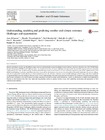Understanding, modeling and predicting weather and climate extremes: Challenges and opportunities
dc.contributor.author
Sillmann, Jana
dc.contributor.author
Thorarinsdottir, Thordis
dc.contributor.author
Keenlyside, Noel
dc.contributor.author
Schaller, Nathalie
dc.contributor.author
Alexander, Lisa V.
dc.contributor.author
Hegerl, Gabriele
dc.contributor.author
Seneviratne, Sonia I.
dc.contributor.author
Vautard, Robert
dc.contributor.author
Zhang, Xuebin
dc.contributor.author
Zwiers, Francis W.
dc.date.accessioned
2018-01-17T10:39:43Z
dc.date.available
2017-12-28T03:39:30Z
dc.date.available
2018-01-17T10:38:15Z
dc.date.available
2018-01-17T10:39:43Z
dc.date.issued
2017-12
dc.identifier.issn
2212-0947
dc.identifier.other
10.1016/j.wace.2017.10.003
en_US
dc.identifier.uri
http://hdl.handle.net/20.500.11850/224708
dc.identifier.doi
10.3929/ethz-b-000224708
dc.description.abstract
Weather and climate extremes are identified as major areas necessitating further progress in climate research and have thus been selected as one of the World Climate Research Programme (WCRP) Grand Challenges. Here, we provide an overview of current challenges and opportunities for scientific progress and cross-community collaboration on the topic of understanding, modeling and predicting extreme events based on an expert workshop organized as part of the implementation of the WCRP Grand Challenge on Weather and Climate Extremes. In general, the development of an extreme event depends on a favorable initial state, the presence of large-scale drivers, and positive local feedbacks, as well as stochastic processes. We, therefore, elaborate on the scientific challenges related to large-scale drivers and local-to-regional feedback processes leading to extreme events. A better understanding of the drivers and processes will improve the prediction of extremes and will support process-based evaluation of the representation of weather and climate extremes in climate model simulations. Further, we discuss how to address these challenges by focusing on short-duration (less than three days) and long-duration (weeks to months) extreme events, their underlying mechanisms and approaches for their evaluation and prediction.
en_US
dc.format
application/pdf
dc.language.iso
en
en_US
dc.publisher
Elsevier
en_US
dc.rights.uri
http://creativecommons.org/licenses/by-nc-nd/4.0/
dc.title
Understanding, modeling and predicting weather and climate extremes: Challenges and opportunities
en_US
dc.type
Journal Article
dc.rights.license
Creative Commons Attribution-NonCommercial-NoDerivatives 4.0 International
dc.date.published
2017-11-04
ethz.journal.title
Weather and Climate Extremes
ethz.journal.volume
18
en_US
ethz.pages.start
65
en_US
ethz.pages.end
74
en_US
ethz.version.deposit
publishedVersion
en_US
ethz.identifier.scopus
ethz.publication.place
Amsterdam
en_US
ethz.publication.status
published
en_US
ethz.date.deposited
2017-12-28T03:39:31Z
ethz.source
SCOPUS
ethz.eth
yes
en_US
ethz.availability
Open access
en_US
ethz.rosetta.installDate
2018-01-17T10:38:18Z
ethz.rosetta.lastUpdated
2022-03-28T18:54:44Z
ethz.rosetta.versionExported
true
ethz.COinS
ctx_ver=Z39.88-2004&rft_val_fmt=info:ofi/fmt:kev:mtx:journal&rft.atitle=Understanding,%20modeling%20and%20predicting%20weather%20and%20climate%20extremes:%20Challenges%20and%20opportunities&rft.jtitle=Weather%20and%20Climate%20Extremes&rft.date=2017-12&rft.volume=18&rft.spage=65&rft.epage=74&rft.issn=2212-0947&rft.au=Sillmann,%20Jana&Thorarinsdottir,%20Thordis&Keenlyside,%20Noel&Schaller,%20Nathalie&Alexander,%20Lisa%20V.&rft.genre=article&rft_id=info:doi/10.1016/j.wace.2017.10.003&
Files in this item
Publication type
-
Journal Article [128813]

